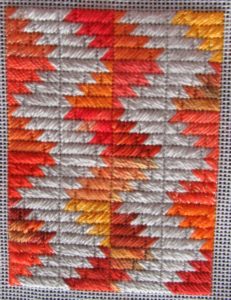
Flames and smoke-filled skies have inspired this needlepoint, based on a quilt. While I didn’t have the shiny threads to do this quilt in the dramatic colors of the recent Napa fires at night, this unusual combination of pale gray and orange creates an image that could also be of autumn.
If you want it to be more like a sunny autumn day, change the gray to light blue and add more yellows and reds to the oranges.
Materials
- 7×8 square 18-mesh canvas
- 1 skein light grey thread (model used Vineyard Silk)
- up to 24 orange threads from scrap pile (yellow-orange and orangish-browns and golds can also be used)
Instructions
The project has 24 blocks, arranged in four columns of six blocks each. Each patch has four rows which are unevenly divided between grey and orange, making a block divided along the diagonal. The blocks are arranged so that they create feathered zig-zag rows. The diagram below shows one block. The patches are all three threads wide and are stitched in Reverse Diagonal Gobelin or Diagonal Gobelin.
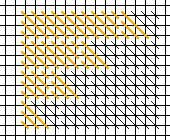
Each of the patches ends in a triangle. These triangles, no matter what color is used, always have three stitches. That makes the small patch where the two triangles meet a rectangle instead of a Scotch Stitch square. This is essential for the balanced look of the quilt portrait.
There are four blocks:
- Block A, above, has orange on the left and grey on the right, with orange increasing in size as you go up. It is in Reverse Diagonal Gobelin.
- Block B, below top, has orange on the left and grey on the right, with orange decreasing in size as you go up. It is in Diagonal Gobelin.
- Block C, below middle, has orange on the right and grey on the left with orange decreasing in size as you go up. It is in Reverse Diagonal Gobelin.
- Block D, below bottom, has orange on the right and grey on the left with orange increasing in size as you go up. It is in Diagonal Gobelin.
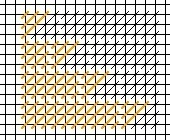
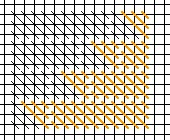
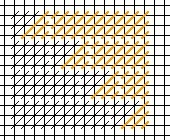
The project is easiest if you stitch all the blocks in one color in one row at once, stitching zig-zag row by zig-zag row.Begin at either lower corner, with the orange patches, Stitch all the orange patches in that column, then the column of grey patches to complete these blocks. Reverse the order for the next column of blocks. The third column repeats the first column and the fourth column repeats the second.
When picking your colors try to have different colors or textures in adjoining blocks. If you have threads that are different in color or texture, spread them around the design.
Columns 1 and 3 are, from bottom to top: A,B,A,B,A,B.
Columns 2 and 4 are, from bottom to top: C,D,C,D,C,D.
About Janet M Perry
Janet Perry is the Internet's leading authority on needlepoint. She designs, teaches and writes, getting raves from her fans for her innovative techniques, extensive knowledge and generous teaching style. A leading writer of stitch guides, she blogs here and lives on an island in the northeast corner of the SF Bay with her family

This is such an interesting pattern. Right away I thought of flames especially given your location. I wonder how it would look in other colors. I could see fall colors for the different trees maybe like on a hill looking down with maybe a road or pathway in between. Or, in greens for crops such as farming or a Christmas tree farm. Or, the pattern cut in a baseball outfield? Blues could be waves like when a boat cuts a path in the water. I don’t know but I think it would be fun just to use some different colors – it is such an interesting pattern. Some day I might have to try my hand at this – maybe a small piece such as yours but wouldn’t a long vertical piece be stunning on a wall? You have peaked my interest!
I agree. I think it would be very cool in other color combinations.
Keep stitching,
Janet